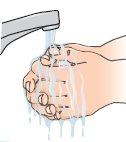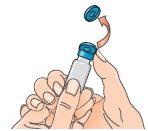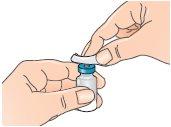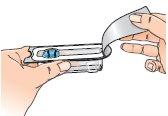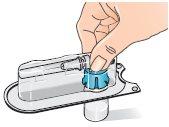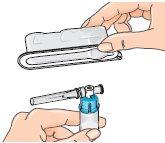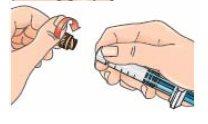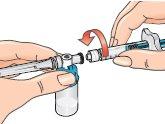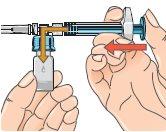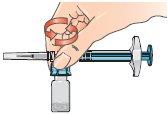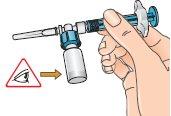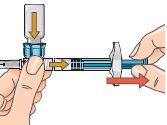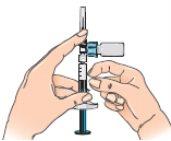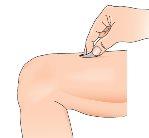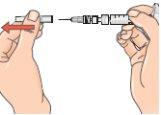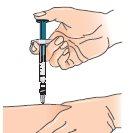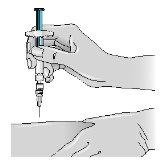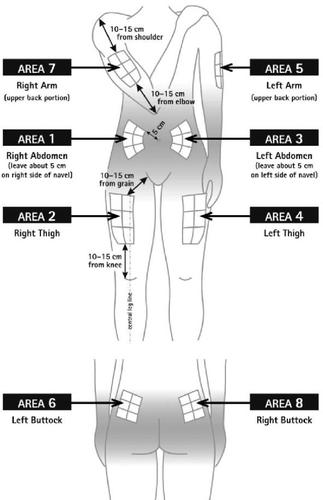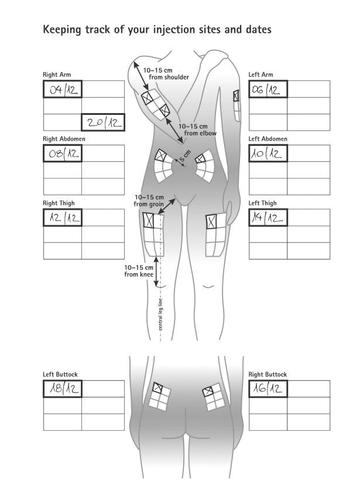
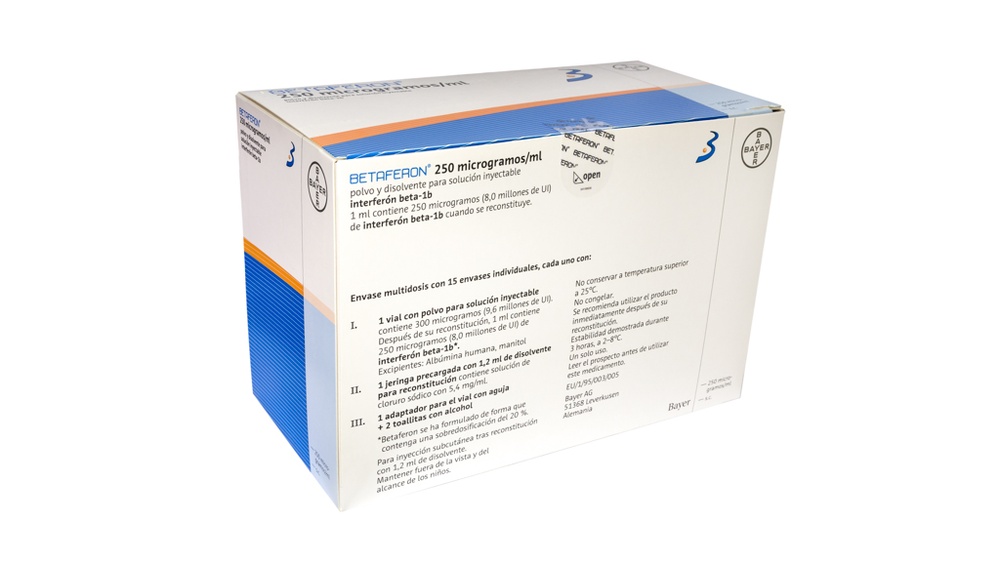
БЕТАФЕРОН 250 мікрограмів/мл ПОРОШОК І РОЗЧИННИК ДЛЯ ПРИГОТУВАННЯ ІН'ЄКЦІЙНОГО РОЗЧИНУ

Запитайте лікаря про рецепт на БЕТАФЕРОН 250 мікрограмів/мл ПОРОШОК І РОЗЧИННИК ДЛЯ ПРИГОТУВАННЯ ІН'ЄКЦІЙНОГО РОЗЧИНУ

Інструкція із застосування БЕТАФЕРОН 250 мікрограмів/мл ПОРОШОК І РОЗЧИННИК ДЛЯ ПРИГОТУВАННЯ ІН'ЄКЦІЙНОГО РОЗЧИНУ
Вступ
Опис: інформація для користувача
Бетаферон 250 мкг/мл, порошок і розчинник для ін'єкційного розчину
інтерферон бета-1б
Перш ніж почати використовувати цей лікарський засіб, уважно прочитайте весь опис, оскільки він містить важливу інформацію для вас.
- Збережіть цей опис, оскільки вам може знадобитися знову його прочитати.
- Якщо у вас виникли питання, проконсультуйтеся з вашим лікарем, фармацевтом або медсестрою.
- Цей лікарський засіб призначений тільки для вас, і його не слід давати іншим людям, навіть якщо вони мають相同ні симптоми, оскільки це може їм нашкодити.
- Якщо ви відчуваєте побічні ефекти, проконсультуйтеся з вашим лікарем, фармацевтом або медсестрою, навіть якщо це побічні ефекти, які не вказані в цьому описі. Див. розділ 4.
Зміст опису
- Що таке Бетаферон і для чого він використовується
- Що потрібно знати перед початком використання Бетаферону
- Як використовувати Бетаферон
- Можливі побічні ефекти
- Зберігання Бетаферону
- Зміст упаковки та додаткова інформація
Додаток – процедура для самостійної ін'єкції
1. Що таке Бетаферон і для чого він використовується
Що таке Бетаферон
Бетаферон – це тип лікарського засобу, відомого як інтерферон, який використовується для лікування розсіяного склерозу. Інтерферони – це білки, які виробляються організмом для боротьби з атаками на імунну систему, такими як вірусні інфекції.
Як діє Бетаферон
Розсіяний склероз (РС)– це хронічне захворювання, яке впливає на центральну нервову систему (ЦНС), зокрема на роботу мозку та спинного мозку. При РС відбувається запалення, яке руйнує захисну оболонку (мієлін) навколо нервів ЦНС, що перешкоджає нормальному функціонуванню нервів. Це називається демієлінізацією.
Точна причина РС невідома. Припускають, що в процесі пошкодження ЦНС грає важливу роль аномальна реакція імунної системи.
Пошкодження ЦНСможе відбуватися під час нападу РС (рецидиву). Це може спричинити тимчасову інвалідність, таку як труднощі з ходьбою. Симптоми можуть зникнути повністю або частково.
Доведено, що інтерферон бета-1б змінює реакцію імунної системи та сприяє зниженню активності захворювання.
Як Бетаферон допомагає боротися з вашим захворюванням
Одна клінічна епізод, яка свідчить про високий ризик розвитку розсіяного склерозу:Доведено, що Бетаферон відкладає прогресування захворювання до розсіяного склерозу.
Розсіяний склероз з рецидивами:Люди з РС з рецидивами мають періодичні напади або рецидиви, під час яких симптоми значно погіршуються. Бетаферон доведено знижує кількість нападів і робить їх менш тяжкими, знижує кількість госпіталізацій через захворювання та подовжує час без рецидивів.
Розсіяний склероз вторинний і прогресивний:В деяких випадках люди з РС з рецидивами помічають, що їхні симптоми збільшуються та прогресують до іншої форми РС, званої вторинним прогресивним РС. При цьому люди стають все більш інвалідними, незалежно від того, чи мають вони рецидиви. Бетаферон може знижувати кількість та тяжкість нападів і відкладати прогресування інвалідності.
Для чого використовується Бетаферон
Бетаферон призначений для використання у пацієнтів
?Хто пережили симптоми вперше, які свідчать про високий ризик розвитку розсіяного склерозу. Ваш лікар виключить інші причини, які могли б пояснити ці симптоми, перш ніж призначити лікування.
?Хто мають розсіяний склероз з рецидивами, з появоющонайменше двох рецидивів за останні два роки.
?Хто мають розсіяний склероз вторинний прогресивний, з активним захворюванням, підтвердженим появою рецидивів.
2. Що потрібно знати перед початком використання Бетаферону
Не використовуйте Бетаферон
- Якщо ви алергічні(гіпersenситивні)до натурального або рекомбінантного інтерферону бета, альбуміну людини або будь-якого іншого компонента цього лікарського засобу (перелічених у розділі 6).
- Якщо ви зараз страждаєте від важкої депресії та/або маєте суїцидальні думки(див. також "Попередження та обережність" та розділ 4. "Можливі побічні ефекти").
- Якщо ви маєте важке захворювання печінки (див. "Попередження та обережність", "Використання Бетаферону з іншими лікарськими засобами" та розділ 4. "Можливі побічні ефекти").
? Повідомте вашому лікареві, якщо будь-яка з цих ситуацій стосується вас.
Попередження та обережність
Проконсультуйтеся з вашим лікарем перед початком використання Бетаферону:
- Якщо ви страждаєте відгаммопатії. Це захворювання імунної системи, при якому в крові виявляється аномальний білок. При використанні лікарських засобів, таких як Бетаферон, можуть виникнути проблеми з малими судинами (капілярами). Це може призвести до шоку (колапсу) та навіть бути смертельним.
- Якщо ви раніше мали депресію або суїцидальні думки. Ваш лікар буде уважно стежити за вашим лікуванням. Якщо ваша депресія та/або суїцидальні думки важкі, вам не буде призначено лікування Бетафероном (див. також "Не використовуйте Бетаферон").
- Якщо ви раніше маликонвульсії, або якщо ви приймаєте лікарські засоби для лікування епілепсії(антієпілептичні засоби), ваш лікар буде уважно стежити за вашим лікуванням (див. також "Використання Бетаферону з іншими лікарськими засобами" та розділ 4. "Можливі побічні ефекти").
- Якщо ви маєтеважкі проблеми з нирками, ваш лікар може стежити за вашою нирковою функцією під час лікування.
Ваш лікар також повинен знати про наступні обставини під час використання Бетаферону:
- Якщо ви відчуваєте симптоми, такі як свербіж по всьому тілу, набряк обличчя та/або язика або раптова труднощі з диханням.Це можуть бути симптоми важкої алергічної реакції (гіпersenситивності), яка може бути смертельною.
- Якщо ви відчуваєте себе значно більш сумним чи безнадійним, ніж раніше лікування Бетафероном, або якщо ви маєте суїцидальні думки.Якщо ви страждаєте від депресії під час лікування Бетафероном, вам може знадобитися спеціальне лікування, і ваш лікар буде уважно стежити за вашим лікуванням і може розглянути можливість переривання лікування. Якщо ви страждаєте від важкої депресії та/або суїцидальних думок, вам не буде призначено лікування Бетафероном (див. також "Не використовуйте Бетаферон").
- Якщо ви помічаєте, що у вас легко виникають синяки, ви кровоточите надто багато при пораненнях, або у вас часто виникають інфекції. Це можуть бути симптоми зниження кількості кров'яних клітин або кількості тромбоцитів у крові (клітин, які сприяють згортанню крові). Вам може знадобитися більш уважне стеження за вашим лікуванням.
- Якщо ви відчуваєте втрату апетиту, втому, нудоту(нудоту), повторювані блювоти, особливо якщо ви помічаєте свербіж по всьому тілу, появу жовтуватого кольору шкіри або білого кольору очей, або якщо у вас легко виникають синяки.Це можуть бути симптоми проблем з печінкою. У деяких клінічних дослідженнях були виявлені зміни у функції печінки у пацієнтів, які приймали Бетаферон. Як і з іншими інтерферонами бета, у рідких випадках було повідомлено про важкі пошкодження печінки, включаючи випадки недостатності печінки, у пацієнтів, які приймали Бетаферон. Найважчі випадки були повідомлені у пацієнтів, які приймали інші лікарські засоби або мали захворювання, які можуть вплинути на печінку (наприклад, зловживання алкоголем, важкі інфекції).
- Якщо ви відчуваєте симптоми, такі як нерегулярні серцеві удари або набряк у ногах чи руках, або труднощі з диханням.Це можуть бути симптоми захворювання серцевого м'яза (міокардопатії), яке було повідомлено у рідких випадках у пацієнтів, які приймали Бетаферон.
- Якщо ви відчуваєте біль у животі, який віддає у спину, і/або якщо ви відчуваєте нудоту або маєте температуру.Це можуть бути симптоми запалення підшлункової залози (панкреатиту), яке було повідомлено при прийомі Бетаферону. Це часто пов'язано з підвищенням рівня деяких жирів у крові (тригліцеридів).
? Перервіть використання Бетаферону та повідомте вашому лікареві негайно, якщо ви відчуваєте будь-який з цих симптомів.
Інші речі, які потрібно пам'ятати при використанні Бетаферону
- Знадобиться аналіз кровідля визначення кількості кров'яних клітин, біохімічних показників крові та ферментів печінки. Це буде зроблено до початку використання Бетаферону, регулярно після початку лікування Бетафероном та періодично під час лікування,навіть якщо у вас немає конкретних симптомів.Ці аналізи крові будуть проведені додатково до аналізів, які проводяться зазвичай для контролю РС.
- Якщо ви маєте захворювання серця,симптоми грипу, які часто виникають на початку лікування, можуть бути надмірним навантаженням для вас.Бетаферон повинен бути використаний з обережністю, і ваш лікар буде стежити за можливим погіршенням вашого серцевого захворювання, особливо на початку лікування. Бетаферон сам по собі не впливає на серце безпосередньо.
- Вам буде проведено перевірку функції щитоподібної залози,регулярно або завжди, коли ваш лікар вважає це необхідним за іншими причинами.
- Бетаферон містить альбумін людини і, отже, пов'язаний зпотенційним ризиком передачі вірусних захворювань. Не можна виключити ризик передачі хвороби Крейтцфельдта-Якоба (ХКЯ).
- Під час лікування Бетаферономваш організм може виробляти речовини, званіантитіла, які можуть реагувати з Бетафероном (нейтралізуюча дія). Не зрозуміло, чи ці антитіла знижують ефективність лікування. Антитіла не виробляються у всіх пацієнтів. Наразі не можна передбачити, які пацієнти належать до цієї групи.
- Під час лікування Бетафероном можуть виникнути проблеми з нирками, які можуть вплинути нафункцію нирок, включаючи рубцювання (гломерулосклероз).Ваш лікар може провести тести для перевірки функції нирок.
- Під час лікування можуть утворюватися кров'яні згортки в малих судинах.Ці згортки можуть вплинути на ваші нирки. Це може трапитися через кілька тижнів або років після початку лікування Бетафероном. Ваш лікар可能 захоче провести контроль вашого артеріального тиску, крові (кількість тромбоцитів) та функції нирок.
- Під час лікування може виникнути блідість, жовтушність шкіри чи темний колір сечі, можливо, разом з незвичайною нудотою, втомою чи труднощами з диханням.Це можуть бути симптоми руйнування червоних кров'яних клітин. Це може трапитися через кілька тижнів або років після початку лікування Бетафероном. Ваш лікар може провести аналізи крові. Повідомте вашому лікареві про інші лікарські засоби, які ви приймаєте одночасно з Бетафероном.
Реакції в місці ін'єкції
Під час лікування Бетаферономвірогідно, що ви відчуватимете реакції в місці ін'єкції.Симптоми включають червоність, набряк, зміну кольору шкіри, запалення, біль та гіпersenситивність. Рідше спостерігаються інфекції навколо місця ін'єкції та пошкодження шкіри та тканин (некроз). Реакції в місці ін'єкції зазвичай стають менш частими з часом.
Пошкодження шкіри та тканин можуть призвести до утворення рубців. Якщо вони важкі, лікар може потребувати проведення видалення чужорідних тіл та мертвої тканини (дебридування) та, рідше, трансплантації шкіри, і процес загоєння може тривати до шести місяців.
Для зниження ризику реакції в місці ін'єкції, таких як інфекція чи некроз, ви повинні:
- Використовувати стерильну техніку ін'єкції (асептичну).
- проводити ротацію місць ін'єкції при кожній ін'єкції (див. Додаток "Процедура для самостійної ін'єкції", Частина II, у другій частині цього опису).
Реакції в місці ін'єкції можуть виникати рідше, якщо ви використовуєте пристрій для самостійної ін'єкції та якщо проводите ротацію місць ін'єкції. Ваш лікар або медсестра можуть повідомити вам про це.
Якщо ви відчуваєте розрив шкіри, який може бути пов'язаний з набряком чи втратою рідини в місці ін'єкції:
- Перервіть ін'єкції Бетаферонута повідомте вашому лікареві.
? Якщо ви маєте один місце ін'єкції з виразкою(пошкодженням)і руйнуванням тканини(некрозом), яке не є надто великим,ви можете продовжувати використовувати Бетаферон.
?Якщо ви маєте декілька місць ін'єкції з виразками(багатьма пошкодженнями),вам потрібно припинити використання Бетаферону до тих пір, поки ваша шкіра не загоїться.
Ваш лікар буде регулярно перевірятисередину, якою ви робите самостійні ін'єкції,особливо якщо ви відчували реакції в місці ін'єкції.
Діти та підлітки
Не проводилися офіційні клінічні дослідження у дітей чи підлітків.
Однак, є деякі дані у дітей та підлітків віком 12-16 років. Ці дані свідчать про те, що профіль безпеки цієї вікової групи є таким самим, як і у дорослих, щодо введення 8,0 млн ОД Бетаферону під шкіру через день. Не має інформації про використання Бетаферону у дітей молодших 12 років. Тому Бетаферон не повинен бути використаний у цій популяції.
Інші лікарські засоби та Бетаферон
Повідомте вашому лікареві або фармацевту, якщо ви використовуєте, нещодавно використовували або можете використовувати інші лікарські засоби, включаючи ті, які можна придбати без рецепта.
Не проводилися офіційні дослідження взаємодії, щоб з'ясувати, чи Бетаферон впливає на інші лікарські засоби або чи його дія змінюється іншими лікарськими засобами.
Не рекомендується використання Бетаферону з іншими лікарськими засобами, які змінюють реакцію імунної системи, крім лікарських засобів, які називаються кортикостероїдамиабо гормоном аденокортикотропіном (АКТГ).
Бетаферон повинен бути використаний з обережністю з:
- Лікарськими засобами, які потребують певної ферментної системи печінкидля їх видалення з організму (відомої як система цитохрому Р450), наприклад, лікарськими засобами, які використовуються для лікування епілепсії (наприклад, фенітойну).
- Лікарськими засобами, які впливають на виробництво кров'яних клітин.
Використання Бетаферону з харчовими продуктами та напоями
Бетаферон вводиться під шкіру, тому не вважається, що будь-яка їжа чи напій, який ви споживаєте, може мати вплив на Бетаферон.
Вагітність та лактація
Якщо ви вагітні або годуєте грудьми, вважаєте, що можете бути вагітною або плануєте вагітність, проконсультуйтеся з вашим лікарем або фармацевтом перед використанням цього лікарського засобу.
Не очікується шкідливого впливу на новонародженого/дитину під час лактації. Бетаферон може бути використаний під час лактації.
Водіння транспортних засобів та використання машин
Бетаферон може викликати побічні ефекти в центральній нервовій системі (див. розділ 4. "Можливі побічні ефекти"). Якщо ви особливо чутливі, це може вплинути на вашу здатність водити транспортні засоби або використовувати машини.
Бетаферон містить манітол, альбумін людини та натрій
Серед неактивних компонентів Бетаферону є
- малі кількості манітолу, природного цукру, та альбуміну людини, білка.
- Натрій - цей лікарський засіб містить менше 1 ммоль натрію (23 мг) на мл; це означає, що він практично "не містить натрію".
Якщо ви алергічні (гіпersenситивні) до будь-якого з цих компонентів або якщо ви станете гіпersenситивними, вам не слід використовувати Бетаферон.
3. Як використовувати Бетаферон
Лікування Бетафероном повинно розпочинатися під наглядом лікаря, який має досвід лікування множинної склерози.
Слідувати точно інструкціям щодо застосування цього лікарського засобу, які вказані вашим лікарем. У разі сумнівів зверніться знову до вашого лікаря, фармацевта або медсестри.
Рекомендована доза:
Через кожні інші дні(один раз на кожні два дні) 1,0 мл приготовленого розчину вводять під шкіру (підшкірно)(див. Додаток «Процедура для самовведення» у другій частині цього листка). Це відповідає 250 мікрограмам (8,0 мільйонів ОД) інтерферону бета-1б.
Коли починається лікування Бетафероном, воно буде краще переноситися, якщо почати з однієї дози та поступово збільшувати, тобто починаючи з 0,25 мл лікарського засобу та подальшого збільшення, після трьох ін'єкцій, спочатку до 0,5 мл, потім до 0,75 мл та нарешті до повної дози (1 мл) Бетаферону.
Ваш лікар може вирішити разом з вами змінити інтервал часу між збільшеннями дози, залежно від побічних ефектів, які ви можете відчувати на початку лікування. Для легкого збільшення дозування під час перших 12 ін'єкцій вам можуть надати спеціальний пакет для збільшення дози, який містить чотири пакети різних кольорів, що включають шприци з особливими маркуваннями та «введений листок для пакету збільшення дози» з детальними інструкціями.
Підготовка ін'єкції
Перед ін'єкцією готується розчин для ін'єкції Бетаферонуз флакону Бетаферон-порошку та 1,2 мл рідини з одного з шприців, попередньо заповнених розчинником. Це робитиме ваш лікар або медсестра, навіть ви самі, після того, як вам буде ретельно пояснено техніку. Для більшої інформації про те, як готується розчин для ін'єкції Бетаферону, див. Додаток «Процедура для самовведення», Частина I.
Включені детальні інструкції для самовведення Бетаферону під шкіруу Частині IЕ Додатка «Процедура для самовведення».
Необхідно регулярно змінювати місце ін'єкції.Див. розділ 2. «Попередження та застереження» та слідуйте інструкціям, вказаним у Частині II «Ротація місць ін'єкції» та Частині III (Календар для введення Бетаферону) Додатка «Процедура для самовведення».
Тривалість лікування
На сьогодні не відомо, протягом якого часу слід лікувати пацієнта. Тривалість лікування повинна бути вирішена лікарем разом з вами.
Якщо ви використовуєте більше Бетаферону, ніж потрібно
Введення доз Бетаферону, значно вищих за рекомендовані для множинної склерози, не призвело до ситуацій, що загрожують життю.
Якщо ви ввели надто багато Бетаферону або ввели його занадто часто, повідомте своєму лікареві.
Якщо ви забули використати Бетаферон
Якщо ви забули зробити ін'єкцію у призначений час, зробіть це якнайшвидше та продовжуйте з наступною, через 48 годин.
Не вводьте подвійну дозу для компенсації забутих доз.
Якщо ви припиняєте лікування Бетафероном
Поговоріть зі своїм лікарем, якщо ви припиняєте або бажаєте припинити лікування. Не відомо, чи припинення Бетаферону викликає гострі симптоми абстиненції.
Якщо у вас є будь-які інші питання щодо використання цього лікарського засобу, запитайте свого лікаря, фармацевта або медсестри.
4. Можливі побічні ефекти
Як і всі лікарські засоби, цей лікарський засіб може викликати побічні ефекти, хоча не всі люди їх відчувають.
Бетаферон може викликати серйозні побічні ефекти. Якщо ви вважаєте, що будь-який з побічних ефектів, які ви відчуваєте, є серйозним, або якщо ви відчуваєте будь-який побічний ефект, не вказаний у цьому листку, повідомте своєму лікареві, фармацевту або медсестрі.
- повідомте своєму лікареві негайно та припиніть використання Бетаферону:
- Якщо ви відчуваєте симптоми, такі як свербіння по всьому тілу, набряк обличчя та/або язика, або раптова труднощі з диханням.
- Якщо ви відчуваєте себе значно більш сумним чи безнадійним, ніж раніше лікування Бетафероном, або якщо у вас є думки про самогубство.
- Якщо ви помітили, що у вас легко з'являються синяки, ви надто сильно кровоточите, коли у вас є рани, або ви часто захворюєте на інфекції.
- Якщо у вас є втрата апетиту, слабкість, нудота, повторювані блювання, особливо якщо ви помітили свербіння по всьому тілу, появу жовтого кольору на шкірі чи в білій частині очей, або якщо у вас легко з'являються синяки.
- Якщо ви відчуваєте симптоми, такі як іррегулярності серцебиття чи набряк у ногах чи руках, або труднощі з диханням.
- Якщо ви помітили біль у животі, який віддає у спину, та/або якщо ви відчуваєте себе марним чи маєте температуру.
повідомте своєму лікареві негайно:
- Якщо у вас є будь-який з цих симптомів: піниста сеча, слабкість, набряк, особливо уногахта на повіках, та збільшення ваги, оскільки вони можуть бути ознаками можливої проблеми з нирками.
Після початку лікування часто з'являються побічні ефекти, але зазвичай вони зменшуються під час продовження лікування.
Найбільш часті побічні ефекти:
?Комплекс симптомів, подібних до грипу,таких як температура, озноб, боль у суглобах, нездужання, потіння, головний біль чи м'язовий біль. Ці симптоми можна зменшити, приймаючи парацетамол або протизапальні засоби, такі як ібупрофен.
?Реакції на місці ін'єкції. Симптоми можуть бути червонінням, набряком, зміною кольору, запаленням, інфекцією, болем, гіперчутливістю чи тканинним ушкодженням (некрозом). Див. «Попередження та застереження» у розділі 2 для більшої інформації та того, що робити, якщо ви відчуваєте реакцію на місці ін'єкції. Ці реакції можна зменшити за допомогою використання пристрою для самовведення та ротації місць ін'єкції. Поговоріть зі своїм лікарем, фармацевтом або медсестрою для отримання додаткової інформації.
Для зменшення побічних ефектів на початку лікування ваш лікар повинен почати з низької дози Бетаферону та поступово збільшувати (див. розділ 3. «Як використовувати Бетаферон»).
Перелік побічних ефектів, наведений нижче, базуєтьсяна повідомленнях клінічних досліджень з Бетафероном та на побічних ефектах, повідомлених про цей лікарський засіб.
?Дуже часті (можуть впливати на більш ніж 1 з 10 пацієнтів):
- зменшення кількості білих кров'яних тілець
- головний біль
- розлади сну (безсоння)
- біль у животі
- специфічна печінкова фермента (аланінова амінотрансфераза або АЛТ) може збільшитися (це буде видно у аналізах крові)
- виразка на шкірі
- розлади шкіри
- біль у м'язах (міалгія)
- ригідність м'язів (гіпертонія)
- біль у суглобах (артралгія)
- термінальна сечова тривожність
- реакція на місці ін'єкції (включаючи червоніння, набряк, зміну кольору, запалення, біль, інфекцію, алергічні реакції (гіперчутливість)
- симптоми, подібні до грипу, біль, температура, озноб, накопичення рідини у руках чи ногах (периферичний набряк), відсутність/втрата сили (астенія)
?Часті (можуть впливати до 1 з 10пацієнтів):
- набряк лімфатичних вузлів (лімфаденопатія)
- може зменшитися кількість червоних кров'яних тілець у крові (анемія)
- щитоподібна залоза не функціонує правильно (виробляє мало гормонів) (гіпотиреоз)
- збільшення чи втрата ваги
- плутаність
- швидкі серцебиття (тахікардія)
- збільшення артеріального тиску (гіпертонія)
- специфічна печінкова фермента (аспартатна амінотрансфераза або АСТ) може збільшитися (це буде видно у аналізах крові)
- труднощі з диханням(диспноє)
- може збільшитися жовто-червоний пігмент (білірубін), вироблений печінкою (це буде видно у аналізах крові)
- виразки на шкірі чи слизових оболонках, набрякові та сверблячі (уртикарія)
- свербіння (прурит)
- випадання волосся (алопеція)
- розлади менструального циклу (менорагія)
- сильне маткове кровотечение (метрорагія) особливо між менструаціями
- імпотенція
- ушкодження шкіри та тканин (некроз) на місці ін'єкції (див. розділ 2 «Попередження та застереження»)
- біль у грудній клітці
- нездужання
?Менше часті (можуть впливати до 1 з 100пацієнтів):
- може зменшитися кількість тромбоцитів (які сприяють згортанню крові) (тромбоцитопенія)
- може збільшитися фракція жиру у крові (тригліцериди) (це буде видно у аналізі крові), див. розділ 2. «Попередження та застереження»
- спроба самогубства
- емоційна нестабільність
- судоми
- може збільшитися специфічна печінкова фермента (гамма ГТ)печінки (це буде видно у аналізі крові)
- запалення печінки (гепатит)
- зміна кольору шкіри
- проблеми з нирками, включно утворення рубців (гломерулосклероз), які можуть зменшити функцію нирок
?Рідкі (можуть впливати до 1 з 1 000пацієнтів):
- згортання крові у малих кровоносних судинах, які можуть вплинути на нирки (тромботична тромбоцитопенічна пурпура чи гемолітичний уремічний синдром). Симптоми можуть включати збільшення кількості синяків, кровотеч, температуру, слабкість, головокружіння чи озноб. Ваш лікар може виявити порушення у крові та функції нирок.
- алергічні реакції (анafilaktični)
- щитоподібна залоза не функціонує правильно (тиреоїдні розлади),виробляє надто багато гормонів (гіпертиреоз)
- значна втрата апетиту, яка призводить до втрати ваги (анорексія)
- хвороба серцевого м'яза (міокардопатія)
- раптова труднощі з диханням (бронхоспазм)
- запалення підшлункової залози (панкреатит), див. розділ 2 «Попередження та застереження»
- печінка не функціонує правильно (ушкодження печінки, включно гепатит, недостатність печінки)
- Частота невідома (частота не може бути оцінена з наявних даних)
- розпад червоних кров'яних тілець (гемолітична анемія)
- можуть виникнути проблеми з малими кровоносними судинами при використанні лікарських засобів, таких як Бетаферон (синдром системної капілярної фільтрації)
- депресія, тривога
- головокружіння
- швидкі серцебиття та нерегулярні чи палпітації (палпітація)
- червоніння та/або еритема обличчя через розширення кровоносних судин (вазодилатація)
- значне звуження кровоносних судин у легенях, яке призводить до збільшення тиску у кровоносних судинах, які транспортують кров від серця до легенів (пульмональна артеріальна гіпертензія). Пульмональна артеріальна гіпертензія була повідомлена на різних етапах лікування, включаючи кілька років після початку лікування Бетафероном.
- нудота
- блювання
- діарея
- виразка на шкірі, червоніння обличчя, біль у суглобах, температура, слабкість та інші симптоми, викликані лікарським засобом (лікарський засіб, індукований лупус еритематоз)
- розлади менструального циклу
- потіння
Повідомлення про побічні ефекти
Якщо ви відчуваєте будь-який побічний ефект, повідомте своєму лікареві, фармацевту або медсестрі, навіть якщо це можливі побічні ефекти, які не вказані у цьому листку. Ви також можете повідомити про них безпосередньо через національну систему повідомлення, включену до Додатка V. Повідомляючи про побічні ефекти, ви можете допомогти надати більше інформації про безпеку цього лікарського засобу.
5. Зберігання Бетаферону
Тримайте цей лікарський засіб поза зоною видимості та досягнення дітей.
Не використовуйте цей лікарський засіб після закінчення терміну придатності, вказаного на упаковці. Термін придатності — останній день місяця, який вказано.
Не зберігайте при температурі вище 25 °C. Не заморожуйте.
Ви повинні використовувати розчин негайно після його підготовки. Однак, якщо це не можливо, він буде придатний для використання протягом 3 годин, якщо зберігатиметься при температурі між 2 °C та 8 °C (у холодильнику).
Не використовуйте Бетаферон, якщо ви помітили, що він містить частинки або має якусь колірність.
Лікарські засоби не повинні викидатися у водопровідні труби чи сміття. Спитайте свого фармацевта, як позбутися упаковок та лікарських засобів, які вам більше не потрібні. Таким чином, ви допоможете захистити навколишнє середовище.
6. Зміст упаковки та додаткова інформація
Склад Бетаферону
Активний інгредієнт- інтерферон бета-1б, 250 мкг на мл після реконституції
Інші компоненти
- У порошку: манітол і альбумін людини.
- У розчиннику: (розчин хлориду натрію з 5,4 мг/мл (0,54% мас/об)): хлорид натрію, вода для ін'єкційних препаратів.
Порошок Бетаферону поставляється у флаконі об'ємом 3 мл, який містить 300 мкг (9,6 млн ОД) інтерферону бета-1б на флакон. Після реконституції кожен мл містить 250 мкг (8,0 млн ОД) інтерферону бета-1б.
Розчинник для Бетаферону поставляється у попередньо наповненому шприці об'ємом 2,25 мл і містить 1,2 мл розчину хлориду натрію з 5,4 мг/мл (0,54% мас/об).
Вигляд продукту та вміст упаковки
Бетаферон - це стерильний білий або майже білий порошок для ін'єкційного розчину.
Бетаферон поставляється у:
- мультидозовій упаковці з 5 індивідуальними упаковками, кожна з яких містить 1 флакон з порошком, 1 попередньо наповнений шприц з розчинником, 1 адаптер для флакону з голкою та 2 ватні тампони з алкоголем, або
- мультидозовій упаковці з 12 індивідуальними упаковками, кожна з яких містить 1 флакон з порошком, 1 попередньо наповнений шприц з розчинником, 1 адаптер для флакону з голкою та 2 ватні тампони з алкоголем, або
- мультидозовій упаковці з 14 індивідуальними упаковками, кожна з яких містить 1 флакон з порошком, 1 попередньо наповнений шприц з розчинником, 1 адаптер для флакону з голкою та 2 ватні тампони з алкоголем, або
- мультидозовій упаковці з 15 індивідуальними упаковками, кожна з яких містить 1 флакон з порошком, 1 попередньо наповнений шприц з розчинником, 1 адаптер для флакону з голкою та 2 ватні тампони з алкоголем, або
- упаковці для 2 місяців з 2 x 14 індивідуальними упаковками, кожна з яких містить 1 флакон з порошком, 1 попередньо наповнений шприц з розчинником, 1 адаптер для флакону з голкою та 2 ватні тампони з алкоголем, або
- упаковці для 3 місяців з 3 x 15 індивідуальними упаковками, кожна з яких містить 1 флакон з порошком, 1 попередньо наповнений шприц з розчинником, 1 адаптер для флакону з голкою та 2 ватні тампони з алкоголем, або
- упаковці для 3 місяців з 3 x 14 індивідуальними упаковками, кожна з яких містить 1 флакон з порошком, 1 попередньо наповнений шприц з розчинником, 1 адаптер для флакону з голкою та 2 ватні тампони з алкоголем, або
- упаковці для налаштування дози для перших 12 ін'єкцій, яка містить 4 потрійні упаковки, кожна з яких містить 3 флакони з порошком, 3 попередньо наповнені шприци з розчинником, 3 адаптери для флакону з голкою та 6 ватних тампонів з алкоголем
Можливо, що тільки деякі розміри упаковок будуть доступні.
Уповноважений на отримання дозволу на розміщення продукції на ринку та відповідальний за виробництво
Уповноважений на отримання дозволу на розміщення продукції на ринку
Bayer AG
51368 Леверкузен
Німеччина
Відповідальний за виробництво
Bayer AG
Мюллерштрасе 178
13353 Берлін
Німеччина
Для отримання додаткової інформації про цей препарат зверніться до місцевого представника уповноваженого на отримання дозволу на розміщення продукції на ринку:
Бельгія / Бельгія / Бельгія Bayer SA-NV Тел: +32-(0)2-535 63 11 | Литва UAB Bayer Тел: +370 5 23 36 868 |
Болгарія Байєр България ЕООД Тел: +359 02 4247280 | Люксембург / Люксембург Bayer SA-NV Тел: +32-(0)2-535 63 11 |
Чехія Bayer s.r.o. Тел: +420 266 101 111 | Угорщина Bayer Hungária Kft. Тел: +36-1-487-41-00 |
Данія Bayer A/S Тел: +45-45 23 50 00 | Мальта Alfred Gera and Sons Ltd. Тел: +356-21 44 62 05 |
Німеччина Bayer Vital GmbH Тел: +49-(0)214-30 513 48 | Нідерланди Bayer B.V. Тел: +31-(0)23-799 1000 |
Естонія Bayer OÜ Тел: +372 655 85 65 | Норвегія Bayer AS Тел: +47 23 13 05 00 |
Греція Bayer Ελλάς ΑΒΕΕ Тел: +30 210 618 75 00 | Австрія Bayer Austria Ges. m. b. H. Тел: +43-(0)1-711 46-0 |
Іспанія Bayer Hispania S.L. Тел: +34-93-495 65 00 | Польща Bayer Sp. z o.o. Тел: +48-22-572 35 00 |
Франція Bayer HealthCare Тел (безкоштовний): +33-(0)800 87 54 54 | Португалія Bayer Portugal, Lda. Тел: +351-21-416 42 00 |
Хорватія Bayer d.o.o. Тел: +385-(0)1-6599 900 | Румунія SC Bayer SRL Тел: +40 21 529 59 00 |
Ірландія Bayer Limited Тел: +353 1 216 3300 | Словенія Bayer d. o. o. Тел: +386-(0)1-58 14 400 |
Ісландія Icepharma hf. Тел: +354 540 80 00 | Словаччина Bayer, spol. s r.o. Тел: +421 2 59 21 31 11 |
Італія Bayer S.p.A. Тел: +39-02-397 81 | Фінляндія Bayer Oy Тел: +358-20 785 21 |
Кіпр NOVAGEM Limited Тел: +357 22 48 38 58 | Швеція Bayer AB Тел: +46-(0)8-580 223 00 |
Латвія SIA Bayer Тел: +371 67 84 55 63 | Велика Британія (Північна Ірландія) Bayer AG Тел: +44 (0) 118 206 3000 |
Дата останнього перегляду цього листка:
Інші джерела інформації
Детальна інформація про цей препарат доступна на сайті Європейського агентства з лікарських засобів: http://www.ema.europa.eu.
Додаток: ПРОЦЕДУРА САМОІН'ЄКЦІЇ
Ваш лікар призначив Бетаферон для лікування вашого захворювання. Ви краще перенесете Бетаферон, якщо почнете з низької дози та поступово збільшуватимете її до повної стандартної дози (див. першу частину цього листка, розділ 3. «Як використовувати Бетаферон»). Для легкого збільшення дозування під час перших 12 ін'єкцій вам можуть надати спеціальну упаковку для налаштування дози, яка містить чотири потрійні упаковки різних кольорів з маркованими шприцами та «Введенням до упаковки для налаштування дози» з детальними інструкціями. Шприци в цій упаковці для налаштування дози марковані згідно з відповідними дозами (0,25; 0,5; 0,75 або 1,0 мл).
Наступні інструкції та ілюстрації призначені для пояснення того, як ви повинні підготувати ін'єкцію Бетаферону та як ви повинні зробити ін'єкцію самостійно. Важливо прочитати інструкції та слідувати їм крок за кроком. Ваш лікар або медсестра інструктуватиме та тренуватиме вас у процедурі та техніці самоін'єкції. Не намагайтесь робити самоін'єкцію, доки не будете впевнені, що зрозуміли, як підготувати розчин для ін'єкції та як зробити ін'єкцію.
ЧАСТИНА I: ПОКРОКОВІ ІНСТРУКЦІЇ
Інструкції включають наступні основні кроки:
- Загальні поради
- Підготовка до ін'єкції.
- Реконституція розчину крок за кроком.
- Підготовка ін'єкції.
- Виконання ін'єкції
- Швидкий огляд процесу.
- Загальні поради
?Почніть добре!
Ви побачите, що за кілька тижнів лікування стане частиною вашого життя. Для початку наступне може допомогти:
- Майте постійно підготовлену зону в будинку, поза зоною видимості та доступу дітей, де вам буде легко знайти Бетаферон та інші інструменти.
Перегляньте умови зберігання в розділі 5 листка: «Зберігання Бетаферону» у першій частині цього листка.
- Спробуйте ін'єктуватися завжди о同じ час, оскільки це буде легше запам'ятати та зарезервувати час, коли вас не буде переривати.
- Підготовьте кожну дозу тільки тоді, коли будете готові зробити ін'єкцію, оскільки її потрібно зробити негайно після реконституції Бетаферону (якщо не використовуєте негайно Бетаферон, перегляньте розділ 5 у першій частині цього листка: «Зберігання Бетаферону»).
?Важливі поради, яких потрібно дотримуватися
- Будьте послідовними. Використовуйте Бетаферон так, як описано в розділі 3, у першій частині цього листка: «Як використовувати Бетаферон». Завжди перевіряйте двічі підготовлену дозу.
- Тримайте контейнер, в якому ви викидаєте шприци та голки, поза зоною видимості та доступу дітей. Закривайте матеріал під замком, якщо це можливо.
- Ніколи не повторно використовуйте шприци та голки.
- Використовуйте завжди стерильну (асептичну) техніку, як описано нижче.
- Викидайте завжди використані шприци тільки в призначеному контейнері.
- Підготовка до ін'єкції
? Як вибрати місце для ін'єкції?
Перед підготовкою ін'єкції Бетаферону вирішіть, де ви будете робити ін'єкцію. Ви повинні робити ін'єкцію Бетаферону в жирній шарі між шкірою та м'язом (тобто в підшкірній клітковині, на глибині 8-12 мм під шкірою). Найкращими місцями для ін'єкції є ті, де шкіра м'яка та гладка, та далеко від суглобів, нервів чи кісток, наприклад, живіт, рука, стегно чи сідниці.
Важливо:Не робіть ін'єкцію в зонах, де ви відчуваєте шишки, синяки, тверді вузли, біль, або зону, в якій шкіра đổiлася, впала, з коростою, або з відкритою раною. Поговоріть з вашим лікарем або медсестрою про ці чи інші незвичайні умови, які ви можете виявити.
Ви повинні змінювати місце ін'єкції кожен раз, коли робите ін'єкцію. Якщо якась зона надто важка для досягнення, можливо, що хтось з членів вашої сім'ї або друзів повинен допомогти вам зробити ін'єкцію. Слідуйте послідовності, описаній у схемі, який включений в кінці Додатка (див. Частина II «Ротація місць ін'єкції»), та повернетеся до першого місця ін'єкції після 8 ін'єкцій (16 днів). За цей час кожне місце ін'єкції повністю відновиться до наступної ін'єкції.
Перегляньте схему ротації, яка знаходиться в кінці цього Додатка, щоб дізнатися, як вибрати місце ін'єкції. Також включений приклад «Календаря для адміністрації» (див. Додаток Частина III). З цим ви будете мати уявлення про те, як контролювати місця та дати ваших ін'єкцій.
?Перевірка вмісту упаковки
У кожній індивідуальній упаковці Бетаферону ви знайдете:
- 1 флакон Бетаферону (з порошком для ін'єкційного розчину)
- 1 попередньо наповнений шприц з розчинником для Бетаферону (розчин хлориду натрію з 5,4 мг/мл (0,54% мас/об))
- 1 адаптер для флакону з голкою
- 2 ватні тампони з алкоголем
Крім того, вам потрібно буде контейнер для викидання шприців та голок.
Використовуйте відповідний дезінфіктор для дезінфекції шкіри.
Якщо у вас є упаковка для налаштування дози Бетаферону, ви знайдете 4 потрійні упаковки різних кольорів та номерів, кожна з яких містить:
- 3 флакони Бетаферону (з порошком для ін'єкційного розчину)
- 3 попередньо наповнені шприци з розчинником для порошку Бетаферону (розчин хлориду натрію 5,4 мг/мл (0,54% мас/об))
- 3 адаптери для флакону з голкою
- 6 ватних тампонів з алкоголем
Крім того, вам потрібно буде контейнер для шприців та голок.
Використовуйте відповідний дезінфіктор для дезінфекції шкіри.
Почніть з потрійної жовтої упаковки 1, яка містить 3 шприци з маркою 0,25 мл, для днів лікування 1, 3 та 5.
Використовуйте далі потрійну червону упаковку 2, яка містить 3 шприци з маркою 0,5 мл, для днів лікування 7, 9 та 11.
Продовжуйте з потрійною зеленою упаковкою 3, яка містить 3 шприци з маркою 0,75 мл, для днів лікування 13, 15 та 17.
Використовуйте потрійну синюю упаковку 4, яка містить 3 шприци з маркою 0,25; 0,5; 0,75 та 1,0 мл, для днів лікування 19, 21 та 23.
- Реконституція розчину, крок за кроком
| 1 - Мийте руки ретельно з водою та милом перед початком цього процесу. |
| 2 - Відкрийте флакон Бетаферону та поставьте його на стіл. Найкраще використовувати великий палець, ніж нігті, оскільки їх можна пошкодити. |
| 3 - Очистіть верхню частину флакону ватним тампоном з алкоголем, рухаючи його тільки в одному напрямку. Покладіть його на флакон. |
| 4 – Відкрийте блистер, який містить адаптер для флакону, але не витягуйте його. Не витягуйте адаптер для флакону з блистера на цьому етапі. Не торкайтеся адаптера. Це потрібно для того, щоб він залишався стерильним. |
| 5 – Перед з'єднанням адаптера викиньте ватний тампон з алкоголем та поставьте флакон на рівну поверхню. 6 - Тримайте блистер за зовнішню поверхню та покладіть його на флакон. Натисніть вниз сильно, поки не почуєте, що він зайняв своє місце на флаконі. |
| 7 - Видаліть блистер з адаптера для флакону, тримаючи його за краї. Тепер він готовий до з'єднання з попередньо наповненим шприцем з розчинником. |
|
|
| 9 - З'єднайте шприц з бічним отвором адаптера для флакону, вставляючи кінець шприца та натискаючи його обережно, повертаючи за годинниковою стрілкою (див. стрілку). Таким чином ви правильно з'єднаєте шприц. |
| 10 - Тримайте шприц, з'єднаний з флаконом, за нижню частину флакону. Повільно натисніть на поршень шприца до самого низу, щоб пропустити весь розчинник у флакон. Відпустіть поршень, який повинен повернутися до свого початкового положення. Це також застосовується до упаковки для налаштування дози. |
| 11 – Не випускаючи шприц, повільно рухайте флакон по колу, щоб розчинити весь сухий порошок Бетаферону. Не агітуйте флакон. |
| 12 - Обережно огляньте розчин, який повинен бути безколірним (прозорим) та не містити частинок. Якщо розчин забарвлений або містить частинки, викиньте його та почніть заново, використовуючи іншу упаковку. Якщо з'являється піна, що може статися, коли флакон агітують або рухається занадто по колу, залиште його на деякий час, поки піна не зникне. |
- Підготовка ін'єкції
| 13 - Якщо поршень повернувся до свого початкового положення, натисніть на нього знову та утримуйте його в цьому положенні. Для підготовки ін'єкції поверніть систему так, щоб флакон був зверху шприца, з ковпачком вниз. Таким чином розчин може текти до шприца. Тримайте шприц у горизонтальному положенні. Повільно витягніть поршень назад, щоб витягнути весь розчин з флакону до шприца. З упаковкою для налаштування дози витягніть розчин тільки до маркування на шприці: 0,25млдля перших трьох ін'єкцій (день 1, 3, 5 лікування), або 0,5млдля ін'єкцій у дні 7, 9, 11 лікування, або 0,75млдля ін'єкцій у дні 13, 15, 17 лікування. Викиньте флакон з будь-яким залишеним розчином. Від дня 19 ви будете вводити повну дозу 1,0мл. |
| 14 – Після видалення розчину поверніть шприц, з'єднаний з флаконом, так, щоб голка вказувала вгору. Це дозволяє повітряним бульбашкам переміститися до верхньої частини розчину. |
15 - Видаліть повітряні бульбашки, давши шприцу легкі поштовхи та натиснувши на поршень до маркування 1 мл, або до об'єму, який призначив ваш лікар. Якщо ви вводите менше 1 мл з упаковкою для налаштування дози, можливо, що не буде повітряних бульбашок, однак для ін'єкції повної дози можуть з'явитися деякі повітряні бульбашки. Видаліть їх. |
Неліпки даючи легенькі поштовхи шприцу пальцем і тиснучи поршень до відповідної позначки на шприці.
Якщо разом з повітряними бульбашками надходить занадто багато розчину в флакон, поверніться до горизонтального положення (див. рисунок 13) і трохи потягніть поршень, щоб знову витягнути розчин з флакона в шприц.
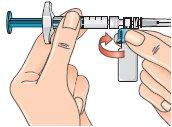
16 - Далі тримайте адаптер для флакона синього кольору, з'єднаний з флаконом, та відокреміть його від шприца, обертаючи вниз, щоб зняти його зі шприца.
Коли робите це, тримайте лише синій пластиковий адаптер. Утримуйте шприц у горизонтальному положенні, з флаконом під шприцем.
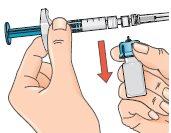
Відокреміть флакон та адаптер від шприца, щоб розчин міг правильно протікати під час ін'єкції.
17 – Витратьте флакон та будь-яку невикористану кількість розчину в контейнер для відходів
18 - Тепер ви готові до ін'єкції.
Якщо з якихось причин ви не можете зробити ін'єкцію Бетаферону негайно, ви можете зберігати реконституований розчин у шприці в холодильнику протягом 3 годин перед використанням. Ніколи не заморожуйте його та не чекайте більше 3 годин для ін'єкції. Якщо пройшло більше трьох годин, витратьте реконституований розчин Бетаферону та підготуйте нову ін'єкцію. Коли використовуєте розчин, нагрійте шприц руками перед ін'єкцією, щоб уникнути болю.
- Виконання ін'єкції
1 - Виберіть місце для ін'єкції (див. поради на початку та діаграми в кінці цього додатку) та позначте його у вашому "Календарі введення". | |
| 2 - Використайте ватний тампон з алкоголем, щоб очистити шкіру в місці ін'єкції: дайте шкірі висохнути на повітрі. Витратьте тампон. Використайте відповідний дезінфікуючий засіб для дезінфекції шкіри. |
| 3 - Зніміть ковпачок з голки, потягнувши його без обертання. |
| 4 - Легенько стисніть шкіру навколо місця ін'єкції, попередньо дезінфікованого (щоб підняти її трохи). |
5 - Тримайте шприц, як олівець або дарт, та тисніть голку в шкіру, утримуючи її прямо під кутом 90 градусів з швидким рухом без коливань. Примітка: Бетаферон також можна вводити за допомогою автоінжектора. | |
6 - Введіть медикамент, тиснучи поршень з повільним та постійним рухом (тисніть поршень до кінця, поки шприц не стане порожнім). | |
7 - Витратьте шприц та голку, покладіть їх у контейнер для відходів. |
- Швидкий огляд процесу
- Видаліть необхідний вміст для ін'єкції.
- Підключіть адаптер для флакона до флакона.
- Підключіть шприц до адаптера для флакона.
- Тисніть поршень шприца, щоб передати весь розчинник до флакона.
- Оберніть систему (флакон над шприцем) та витягніть необхідну кількість розчину.
- Зніміть флакон зі шприца; тепер він готовий до ін'єкції.
ПРИМІТКА: Ін'єкцію слід вводити негайно після змішування (якщо ін'єкцію відкладено, зберігайте розчин у холодильнику та вводьте його протягом наступних трьох годин). Не заморожуйте.
ЧАСТИНА II:РОТАЦІЯ МІСЦЬ ІН'ЄКЦІЇ
Ви повинні вибрати нове місце для кожної ін'єкції, щоб дати час зоні для відновлення та допомогти запобігти інфекції. У першій частині цього додатку надаються поради щодо вибору областей. Це хороша ідея знати, де буде зроблена ін'єкція, перш ніж підготувати шприц. Схема, показана на діаграмі нижче, допоможе вам змінювати місця правильно. Наприклад, введіть першу ін'єкцію в правій частині живота, виберіть ліву частину для другої ін'єкції, потім перейдіть до правої частини стегна для третьої ін'єкції та так далі через діаграму, поки не будуть використані всі відповідні області тіла. Зберігайте запис про те, де та коли була зроблена остання ін'єкція. Одним із способів зробити це є записування цієї інформації у "Календарі введення", який супроводжує.
Слідуючи цій схемі, ви повернетеся до початкового місця (тобто правої частини живота) після 8 ін'єкцій (16 днів). Це називається "Циклом ротації". У нашому прикладі календаря кожна з 8 тілесних областей була розділена на 6 місць ін'єкції (всього 48 місць для ін'єкцій), лівих та правих: верхніх, середніх та нижніх частин кожної тілесної області. Коли ви повернетеся до області ін'єкції після закінчення циклу ротації, виберіть область, що знаходиться найдалі всередині цієї області. Якщо з'являється будь-яка виразка, проконсультуйтеся з лікарем або медсестрою перед вибором інших місць ін'єкції.
Календар ротації:
Щоб допомогти вам правильно змінювати місця ін'єкції, рекомендуємо вам заповнити реєстр з датою та місцем ін'єкції. Ви можете використовувати наступну схему ротації.
Працюйте кожен цикл ротації послідовно. Кожен цикл складатиметься з восьми ін'єкцій (16 днів), введених від першої області до восьмої області по черзі. Слідуючи цій послідовності, ви дáte кожній області можливість відновитися до наступної ін'єкції.
Перший цикл ротації:Верхня ліва частина кожної області
Другий цикл ротації:Нижня права частина кожної області
Третій цикл ротації:Центральна ліва частина кожної області
Четвертий цикл ротації:Верхня права частина кожної області
П'ятий цикл ротації:Нижня ліва частина кожної області
Шостий цикл ротації:Центральна права частина кожної області
КАЛЕНДАР РОТАЦІЇ: |
|
ЧАСТИНА III:КАЛЕНДАР ВВЕДЕННЯ БЕТАФЕРОНУ
Інструкції для контролю місць та дат ін'єкції
- Виберіть місце ін'єкції для першої ін'єкції.
- Очистіть місце ін'єкції ватним тампоном з алкоголем та дайте йому висохнути на повітрі.
- Після ін'єкції заповніть місце ін'єкції та дату у "Календарі введення" (див. приклад на наступній сторінці з інструкціями для контролю місць та дат ін'єкції).
ПРИКЛАД КАЛЕНДАРЯ ВВЕДЕННЯ: |
|
---------------------------------------------------------------------------------------------------------------------------
ДОДАТОК: ВСТУПНИЙ ПРОСПЕКТ ПАКУВАННЯ ДЛЯ ЕСКАЛАЦІЇ ДОЗИ
Ваш лікар призначив Бетаферон для лікування вашого розсіяного склерозу. Ви краще перенесете Бетаферон, якщо почнете з низької дози та поступово збільшите її до повної стандартної дози (див. першу частину проспекту, розділ 3. "Як використовувати Бетаферон"). Шприци в цьому пакуванні для ескалації дози позначені згідно з відповідними дозами (0,25; 0,5; 0,75 або 1,0 мл).
? Перевірка вмісту пакування
У пакуванні для ескалації дози Бетаферону ви знайдете 4 триплексні пакування різних кольорів та номерів, кожне з яких містить:
- 3 флакони Бетаферону (з порошком для розчинної ін'єкції)
- 3 шприци, попередньо заповнені розчинником для порошку Бетаферону (розчин хлориду натрію 5,4 мг/мл (0,54% п/в))
- 3 адаптери для флакона з голкою
- 6 ватних тампонів з алкоголем
Кожне триплексне пакування містить шприци, які вам знадобляться для підготовки кожної дози. Шприци мають спеціальні позначення для цієї дози. Слідуйте уважно інструкціям з використання, які наведені нижче. Для кожного етапу регулювання дози використовуйте повну кількість розчинника для реконституції порошку Бетаферону, а потім витягніть необхідну дозу шприцем.
Почніть з використання жовтого триплексного пакування, яке чітко позначено цифрою "1"у правому верхньому куті коробки.
Це перше триплексне пакування слід використовувати для днів лікування 1, 3 та 5.
Воно містить шприци, спеціально позначені марками 0,25мл. Це допоможе вам вводити лише необхідну дозу.
Після закінчення жовтого пакування почніть використовувати червоне триплексне пакування, яке чітко позначено цифрою "2"у правому верхньому куті коробки.
Це друге триплексне пакування слід використовувати для днів лікування 7, 9 та 11.
Воно містить шприци, спеціально позначені марками 0,50мл. Це допоможе вам вводити лише необхідну дозу.
Після закінчення червоного пакування почніть використовувати зелене триплексне пакування, яке чітко позначено цифрою "3"у правому верхньому куті коробки
Це третє триплексне пакування слід використовувати для днів лікування 13, 15 та 17.
Воно містить шприци, спеціально позначені марками 0,75мл. Це допоможе вам вводити лише необхідну дозу.
Нарешті, після закінчення зеленого пакування почніть використовувати синє триплексне пакування, яке чітко позначено цифрою "4"у правому верхньому куті коробки. Це останнє триплексне пакування слід використовувати для днів лікування 19, 21 та 23.
Воно містить шприци з марками 0,25, 0,5, 0,75 та 1,0мл. З допомогою четвертого триплексного пакування ви можете вводити повну дозу 1,0 мл.
Для опису того, як підготувати та використовувати порошок Бетаферону, див. розділ 3. "Як використовувати Бетаферон" у першій частині проспекту та додаток "Процедура для самоін'єкції" у другій частині проспекту.
Крім того, вам знадобиться контейнер для шприців та голок, які були використані.
- Країна реєстрації
- Діючі речовини
- Потрібен рецептТак
- Виробник
- Інформація є довідковою і не є медичною порадою. Перед прийомом будь-яких препаратів обов'язково проконсультуйтеся з лікарем. Oladoctor не несе відповідальності за медичні рішення, прийняті на основі цього контенту.
- Альтернативи до БЕТАФЕРОН 250 мікрограмів/мл ПОРОШОК І РОЗЧИННИК ДЛЯ ПРИГОТУВАННЯ ІН'ЄКЦІЙНОГО РОЗЧИНУФорма випуску: РОЗЧИН ДЛЯ ІН'ЄКЦІЙ, 300 мкгДіючі речовини: interferon beta-1bВиробник: Bayer AgПотрібен рецептФорма випуску: РОЗЧИН ДЛЯ ІН'ЄКЦІЙ, 30 мкгДіючі речовини: interferon beta-1aВиробник: Biogen Netherlands B.V.Потрібен рецептФорма випуску: РОЗЧИН ДЛЯ ІН'ЄКЦІЙ, 30 мкгДіючі речовини: interferon beta-1aВиробник: Biogen Netherlands B.V.Потрібен рецепт
Аналоги БЕТАФЕРОН 250 мікрограмів/мл ПОРОШОК І РОЗЧИННИК ДЛЯ ПРИГОТУВАННЯ ІН'ЄКЦІЙНОГО РОЗЧИНУ в інших країнах
Найкращі аналоги з тією самою діючою речовиною та терапевтичним ефектом.
Аналог БЕТАФЕРОН 250 мікрограмів/мл ПОРОШОК І РОЗЧИННИК ДЛЯ ПРИГОТУВАННЯ ІН'ЄКЦІЙНОГО РОЗЧИНУ у Украина
Лікарі онлайн щодо БЕТАФЕРОН 250 мікрограмів/мл ПОРОШОК І РОЗЧИННИК ДЛЯ ПРИГОТУВАННЯ ІН'ЄКЦІЙНОГО РОЗЧИНУ
Консультація щодо дозування, побічних ефектів, взаємодій, протипоказань та поновлення рецепта на БЕТАФЕРОН 250 мікрограмів/мл ПОРОШОК І РОЗЧИННИК ДЛЯ ПРИГОТУВАННЯ ІН'ЄКЦІЙНОГО РОЗЧИНУ – за рішенням лікаря та згідно з місцевими правилами.




